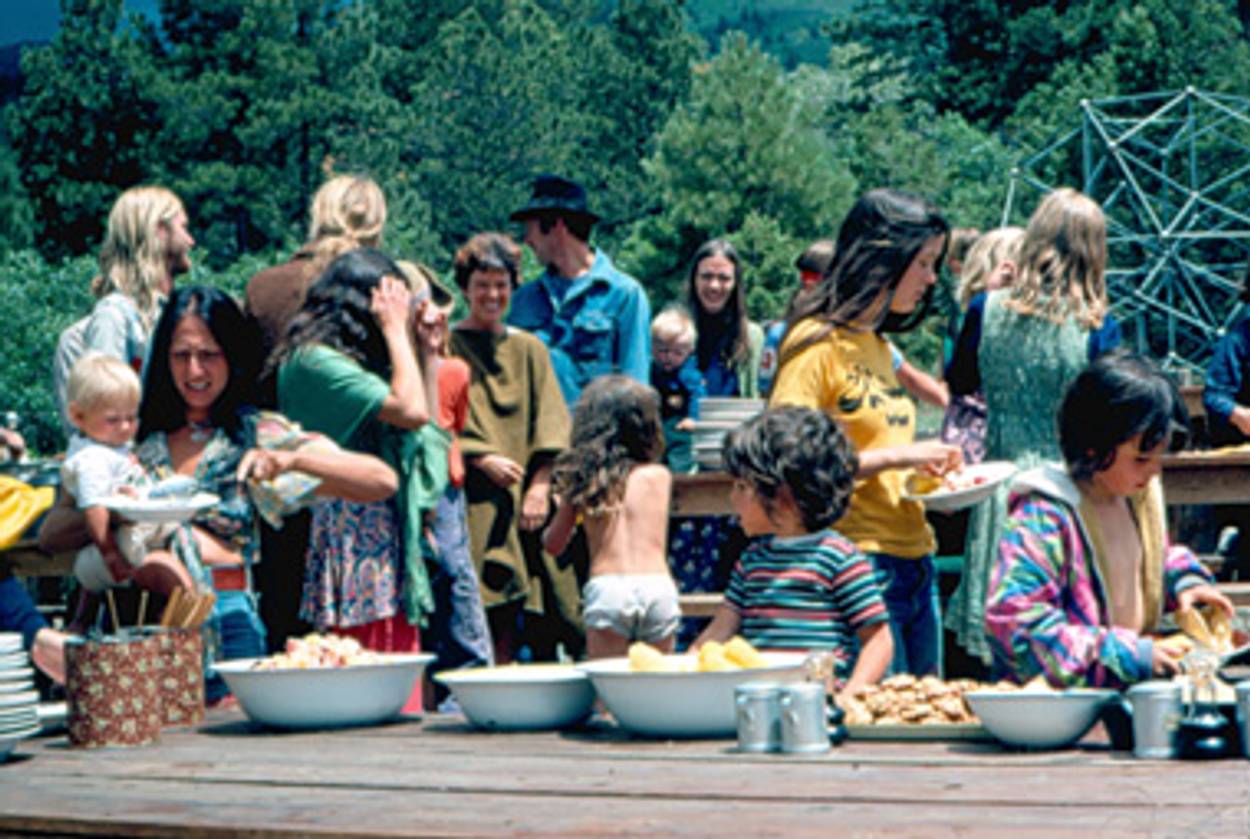Ecstatic
The author was a fan of essayist Seymour Krim’s lively prose, but it wasn’t until a joint visit to a Taos commune that he saw the man himself come fully alive




Until news reached me of Mark Cohen’s compilation of Seymour Krim’s essays, Missing a Beat: The Rants and Regrets of Seymour Krim, I wondered if anyone but me remembered him. After his suicide in 1989, Krim’s friend Peggy Brooks and others assembled a collection of essays, What’s This Cat’s Story (1991), providing the beat writer with a brief posthumous encore before disappearing entirely like a transient radar blip. We should be grateful to Cohen for assembling and publishing these pieces, which he calls “rants and regrets.” As largely they are. Certain essays in this collection should never be allowed to go out of print: in particular “What’s This Cat’s Story?” and “Ask for a White Cadillac.” Another dozen are like family sterling that needs the occasional opening up and dusting off. Aside from the fact that Krim had one of the most distinctive voices of his generation—postwar New York intellectual—his rare ability to express the delicate and seamy undersides of human emotions continues to astonish me.
I met Krim in the summer of 1976, when both of us happened to be in Taos, New Mexico. That summer, my wife, my 2-year-old daughter, and I jammed our gear into a cramped Peugeot and drove to Taos—a locale that for me vibrated with names like D.H. Lawrence, Mabel Dodge Luhan, Ansel Adams, Georgia O’Keefe, and in those days the late actor Dennis Hopper—and settled into a house on Upper Ranchitos Road, with an adobe floor and vigas for ceiling beams. From our front door we could see both El Salto Mountain and the Rio Pueblo sluicing across the front yard. I had planned a summer of reading, of Jewish-American novelists and essayists, though the rugged splendor of the high desert countryside made that game plan feel decidedly parochial most of the time. As it turned out, I didn’t haul my books around with me down every river gorge or up every mountain trail.
Among the titles I had stuffed into my bag were Krim’s essay collections, whose voice, a churning lava of chutzpah and self-recital, I had found cleansing after the cobwebs of literary criticism that, in my job as English professor at SUNY, Buffalo, had entangled me all that year. His Jewish-Whitmanesque rhapsodies and dirges, for his own “disgusting self-murder” as a book reviewer and for friends “becoming increasingly more exacting, fussy, competitive, fanatical, less human in their writing and standards,” were like jungle-strength weed killer for my own insanely manicured academic writing. Views of a Nearsighted Cannoneer (1961), Shake It for the World, Smartass (1970), The Beats (1960; editor), and You and Me (1974) were packed in my going-to-the-country kit, and so I found it particularly thrilling to learn that Krim was in town, in residence at the Helene Wurlitzer Foundation, and would be reading at Talley Richards’s Gallery of Contemporary Art.
Krim read that night from a prose-poem that was his long-term preoccupation, a manifesto-soliloquy titled “Chaos,” which sounded to my ears like James Joyce as interpreted by Dizzy Gillespie. “For years we’ve calculated our lives, thought them out, but I tell you that’s not enough, we have to shout them out too, oh nuts! Just fingerpop to the beat and it’ll get you through, got to trust your boogie-woogie Jew!” “Chaos” was hippy, flippy, dippy, and trippy, a paste-up of bohemian rhapsodies and Village jive talk, accompanied by a flute player improvising in the background. There he was, the boogie-woogie Jew in the flesh, rapping out an epic to his own soul, a generation after bebop and a quarter-century before hip-hop. “Chaos” would have been at home at San Francisco’s Six Gallery, where the best minds of the Beat generation had launched their assault on the capitalist Moloch 21 years earlier and whose anarchist soul remained alive and well in this New Mexican haven of artists and seekers and hippies and revolutionaries and Indians and Hispanics—all armed against the others—on sacred ground between the Taos Pueblo and heaven.
My wife and I began to see Krim, sometimes in the company of Talley Richards, with whom he was waging a difficult relationship. She herself was a refugee from New York, where she had been a dancer, had rubbed shoulders with mobsters and tycoons, and now lived in a house in Cañon built of old ammunition boxes. (Recycling-as-architecture was very much the fashion in those days.) This I only learned much later from an obit in the Taos News. She was smart, feisty, and beautiful, I mean blast-a-hole-in-your-ozone-layer beautiful, and I could not help but wonder if Seymour wasn’t overmatched with her. There he was, the nearsighted cannoneer, with thick lenses in his wire-framed Trotsky glasses, hitching his wagon to one of the fixed stars in the Taos firmament. “Togetherness is a slippery slope,” he wrote to me during the following Fall, “but we’re hanging in there.” We had them over for dinner—a boisterous, gabby evening, well-lubricated with wine, except for Richards, who kept her glass filled with water. But she kept conversational stride with Krim, who talked as he wrote, in 900-foot home runs of language.
Krim and I saw a lot of each other that summer, and toward the end we drove to the Lama Foundation, where I caught a glimpse of something that would have escaped me otherwise. Lama, a community in the mountains north of Taos, had been founded in the 1960s by Baba Ram Dass (formerly Richard Alpert) as a spiritual retreat, and it had regular Sunday open houses. Where other rural communes of the 1970s have long-since disbanded or become bed-and-breakfasts, like the New Buffalo Commune in Arroyo Hondo, the Lama Foundation survives to this day, thanks to its eclectic spiritual practices and pragmatic management. It is a testament to the kind of sustainable anarchism that defines Taos.
Lama is Spanish for mud, not Tibetan for Dalai, and the commune is situated in the muddy reaches of the Sangre de Cristo mountains, about 8,600 feet up. Upon arriving, Krim and I were greeted by a panorama of home-made buildings, all designed after Buckminster Fuller’s geodesic plan—interlocking triangles for strength without mass—under adobe exteriors. Among them was a large geodesic structure used for ceremonial gatherings, and visitors were ushered into the big dome for spiritual refreshment. To the accompaniment of drums and guitar we were led around in a circle dance while chanting the names of many gods: Allah, Yahweh, Buddha, Adonai, Jesus, Shiva, Chango, Babalu—the gantse polytheistic mishpokhe. I don’t recall details; I just remember shuffling and chanting, and if you’ve never done that at 8,600 feet, let me tell you, euphoria is just minutes away.
But my own euphorias tend to be modulated; I’m too ironic for religious trances and probably can’t be hypnotized. But I was astonished to see that Krim, this New York writer and sometime Beatnik, was completely into it. His eyes were closed and he was chanting away and breathing from the diaphragm. I was a little in awe of that—no, a lot in awe—since such surrender is not in my emotional toolkit. He reminded me of poet Allen Ginsberg chanting himself into a mood to read poetry. Or maybe he was just doing the Flat Foot Floogie with the Floy Floy. Afterwards, outdoors with the Taos valley spread out thousands of feet below us, a young woman stopped by to ask us if we would be able to come back Friday night for Shabbos. “Shabbos?” “Yes, Shabbos. Last year a group of Hasidim came up here, and we discovered that we had so much in common spiritually that we decided to add Shabbos to our list of holy observances.”
When I visited him in New York, Krim had me listen to his latest musical passion: the James Cotton Band, and we listened for a half hour to James Cotton wailing on his axe, the blues harmonica, for a half hour before going for dinner. Krim was ever the boogie woogie Jew. But his response at Lama remains the vivid tableau: the secular Hasid, someone in whom the Hasidic spirit was primed for revival generations after the beliefs and observances had been lost. He was a case of a Hasidic ecstasy flaring up in the absence of a devotional community to direct it. I saw it in Lama, I heard it in his love for James Cotton, and heard it that night in the reading of “Chaos” at the art gallery.
In Missing a Beat, Mark Cohen has brought that voice back to life. The volume is a mixture of chestnuts from the earlier collections (“What’s This Cat’s Story?,” “Making It,” “Milton Klonsky, My Favorite Intellectual,” “Norman Mailer, Get Out of My Head”), reclamations from small magazines, like “On Being an Anglo” which appeared in Stroker, an avant-garde review published in Japan, and unpublished discoveries from the Krim archive in Iowa City, like “Black English, or The Motherfucker Culture.” Cohen has wisely chosen to leave out the early “self-murdering” literary criticism and focus on Krim’s later howls for himself and the best minds of his generation destroyed by ambition.
Some of these essays are musts for anyone who could be fascinated by watching a mind at work declaiming against its own vanities and ambitions. Krim wrote unflinchingly about the costs, in morale and self-respect, of the fame game. “What’s This Cat’s Story?” “Making It,” and “For My Brothers and Sisters in the Failure Business” are his protests against the “self-congratulating, aloof intellectual bazaar” of his generation. Mining his soul as he went, he chronicled his adventures in Harlem, where he went for sex, music, and for whatever else came his way, including being robbed. “Ask for the White Cadillac,” his memoir of that time, prompted James Baldwin to say, “God bless him, almost the only writer of my generation who has managed to release himself from the necessity of being either romantic or defensive about Negroes.” It is light-years more honest and self-probing than Norman Mailer’s celebrated manifesto “The White Negro,” and Krim resented the adulation that followed Mailer. Out of that resentment came “Norman Mailer, Get Out of My Head.” Krim had captured both the allure and the perils of Harlem for adventure-starved white men more forthrightly than had Mailer, while the latter reaped all the adoration.
Krim never played teacher with me, but he became one all the same. After all these years he remains one of the “good voices in my head,” to invoke Ted Solotaroff’s phrase, and my debt to him now extends to Mark Cohen as well, for his masterful job of bringing Seymour Krim back on stage for this triumphant curtain call.
Mark Shechner is a professor of English at the University at Buffalo.
Mark Shechner is a professor of English at the University at Buffalo.